
The Muslim period in the Indian subcontinent or Indo-Muslim period is conventionally said to have started in 712, after the conquest of Sindh and Multan by the Umayyad Caliphate under the military command of Muhammad ibn al-Qasim. It began in the Indian subcontinent in the course of a gradual conquest. The perfunctory rule by the Ghaznavids in Punjab was followed by Ghurids, and Sultan Muhammad of Ghor is generally credited with laying the foundation of Muslim rule in Northern India.
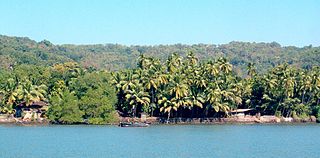
The Konkan is a stretch of land by the western coast of India, bound by the river Daman Ganga at Damaon in the north, to Anjediva Island next to Karwar town in the south; with the Arabian Sea to the west and the Deccan plateau to the east. The hinterland east of the coast has numerous river valleys, riverine islands and the hilly slopes known as the Western Ghats; that lead up into the tablelands of the Deccan. The region has been recognised by name, since at least the time of Strabo in the third century CE. It had a thriving mercantile port with Arab tradesmen from the 10th century. The best-known islands of Konkan are Ilhas de Goa, the site of the Goa state's capital at Panjim; also, the Seven Islands of Bombay, on which lies Mumbai, the capital of Maharashtra and the headquarters of Konkan Division.
Nawab is a royal title indicating a ruler, often of a South Asian state, in many ways comparable to the western title of Prince. The relationship of a Nawab to the Emperor of India has been compared to that of the Kings of Saxony to the German Emperor. In earlier times the title was ratified and bestowed by the reigning Mughal emperor to semi-autonomous Muslim rulers of subdivisions or princely states in the Indian subcontinent loyal to the Mughal Empire, for example the Nawabs of Bengal.

Islam is India's second-largest religion, with 14.2% of the country's population, or approximately 172.2 million people, identifying as adherents of Islam in a 2011 census. India also has the third-largest number of Muslims in the world. The majority of India's Muslims are Sunni, with Shia making up around 15% of the Muslim population.
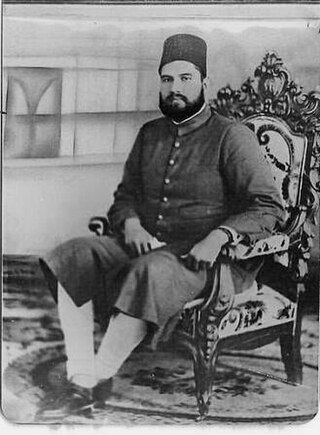
Nawab Bahadur Yar Jung was an Indian politician and foremost Muslim leader in the princely state of Hyderabad in British India. He founded All India Majlis-e-Ittehadul Muslimeen and the branches of Khaksars in Hyderabad and was known as a powerful religious preacher. In 1938, he was elected the President of Majlis-e-Ittehadul Muslimeen, a position in which he served till his death.
Bhatkal is a coastal town in the Uttara Kannada District of the Indian state of Karnataka. Bhatkal lies on National Highway 66, which runs between Mumbai and Kanyakumari, and has Bhatkal railway station which is one of the major railway stations along the Konkan Railway line, which runs between Mumbai and Mangalore.

Gingee, also known as Senji or Jinji and originally called Singapuri, is a panchayat town in Viluppuram district in the Indian state of Tamil Nadu. Gingee is located between three hills covering a perimeter of 3 km, and lies west of the Sankaraparani River.

Konkani Muslims are an ethnoreligious subgroup of the Konkani people of the Konkani region along the west coast of India, who practice Islam. Nawayath and "Nakhuda" Muslims from the North Canara district of Karnataka have similar origin as Konkani Muslims, but show a distinct ethnolinguistic identity due to geographical isolation of the Canara coast from the Konkan coast.
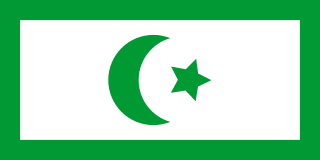
The Carnatic Sultanate was a kingdom in South India between about 1690 and 1855, and was under the legal purview of the Nizam of Hyderabad, until their demise. They initially had their capital at Arcot in the present-day Indian state of Tamil Nadu. Their rule is an important period in the history of the Carnatic and Coromandel Coast regions, in which the Mughal Empire gave way to the rising influence of the Maratha Empire, and later the emergence of the British Raj.
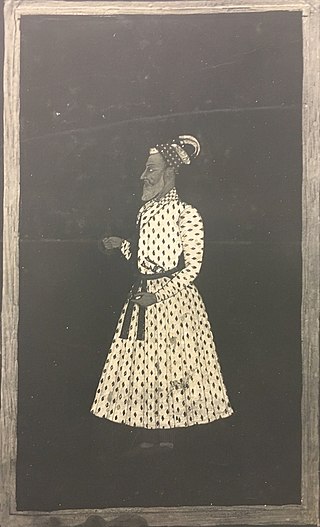
Sa'adatullah Khan I or Sa'adatullah Khan was Nawab of Carnatic (r.1710–1732) and founder of Nawayath dynasty. He was an adventurer from Konkan in Maharashtra.
Jat Muslim or Musalman Jat, also spelled Jatt or Jutt, are an elastic and diverse ethno-social subgroup of the Jat people, who are composed of followers of Islam and are native to the northern regions of the Indian subcontinent. They are found primarily throughout the Sindh and Punjab regions of Pakistan. Jats began converting to Islam from the early Medieval era onward and constitute a distinct subgroup within the diverse community of Jat people.

The Hadharem or the Hadhrami are an Ethnographic group of Arabs indigenous to the Hadhramaut region in South Arabia, which is part of modern-day Yemen. The group's dialect or speech is known as Hadhrami Arabic. Among the two million inhabitants of Hadhramaut, there are about 1,300 distinct tribes.
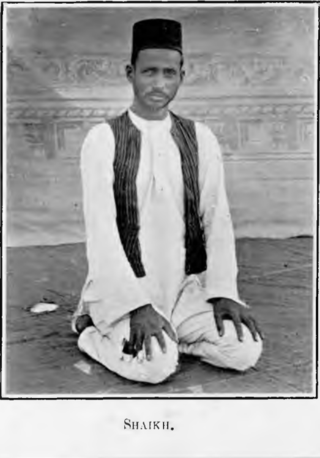
Arabs in India are people with Arab origins who have over a long period of time, settled in the Indian subcontinent. There have been extensive trade and cultural links between India and the Arab world spanning several millennia. The west coast region of India, especially Malabar and Konkan coasts were active trading hubs, where Arab merchants frequently used to visit on their way to Sri Lanka and South East Asia. Over a span of several centuries, migrants from different Arabian nations immigrated to various regions and kingdoms of the Indian subcontinent as merchants, missionaries and through intermarriages.
Manki or Mankipura is a village in Honnavar Taluk, Uttara Kannada district of Karnataka, India. It is located on the shore of the Arabian Sea and between Goa and Mangalore, about 100 km from Karwar. It lies on NH-66 running between Mumbai and Mangalore.
The Goan Muslims are a minority community who follow Islam in the Indian coastal state of Goa, some are also present in the union territory of Damaon, Diu & Silvassa. They are native to Goa, unlike recent Muslim migrants from mainland India, and are commonly referred to as Moir by Goans in Goan Konkani.[a]Moir is derived from the Portuguese word Mouro. The Portuguese called them Mouros because they were in contact with the Moors, people of predominantly Muslim Maghreb country, who had conquered and colonised the Iberian peninsula for centuries.

Sayyid Muḥammad Ṣiddīq Ḥasan Khān al-Qannawjī was an Islamic scholar and leader of India's Muslim community in the 19th century, often considered to be the most important Muslim scholar of the Bhopal State. He is largely credited alongside Syed Nazeer Husain with founding the revivalist Ahl-i Hadith movement, which became the dominant strain of Sunni Islam throughout the immediate region. Siddiq Hasan Khan was also a prominent scholarly authority of the Arab Salafiyya movement of the late 19th and early 20th centuries.
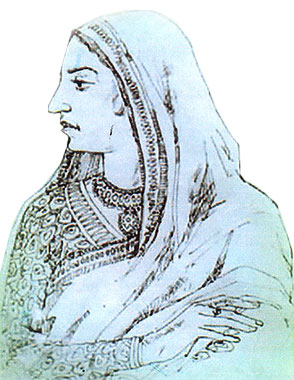
Nawab Begum Faizunnesa Choudhurani was Zamindar of Homnabad-Pashchimgaon Estate in present-day Comilla District, Bangladesh. She is most famous for her campaign for female education and other social issues. In appreciation of her social work, in 1889 Queen Victoria awarded Faizunnesa the title of "Nawab", making her the first female Nawab in South Asia.

Nawab "Ghazanfar-Jang"Bangash Khan (1665–1743) was the first Nawab of Farrukhabad in Uttar Pradesh, India. He was a "Bawan Hazari Sardar" in the Mughal Army. He served as governor of Malwa and Allahabad provinces of the Mughal Empire. He was also viceroy of Assam from 1735 to 1743. Although regarded as rude and illiterate, not understanding a single word of Persian or Pashto, he was well regarded for his loyalty, and it is believed that had fortune sided with him he would have been able to establish a kingdom rivalling those in the Deccan or Awadh.
Events in the year 1855 in India.
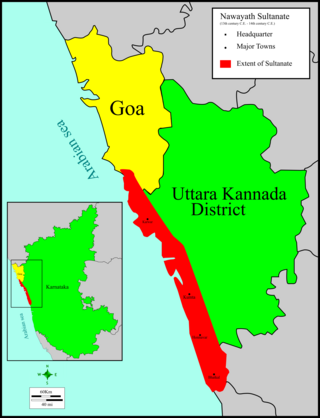
Nawayath Sultanate also known as Hunnur Sultanate, was a tiny kingdom on the coast of Karavali, present-day Uttara Kannada district of Karnataka. It was probably established by Nawayath merchant Hasan Nakhuda at Hospattan, the village in Honnavar. It remained a sovereign kingdom until 1340, when the Harihara-nripala, the king of the unknown kingdom of Gersoppa, who controls the eastern part of the Sultanate, established his suzerainty over Sultan Jamaluddin. Unlike most of the kingdoms of the Indian Subcontinent, it was capable of marine warfare and possessed two of the most notable ships, namely the Tarida and the Ukairi.













